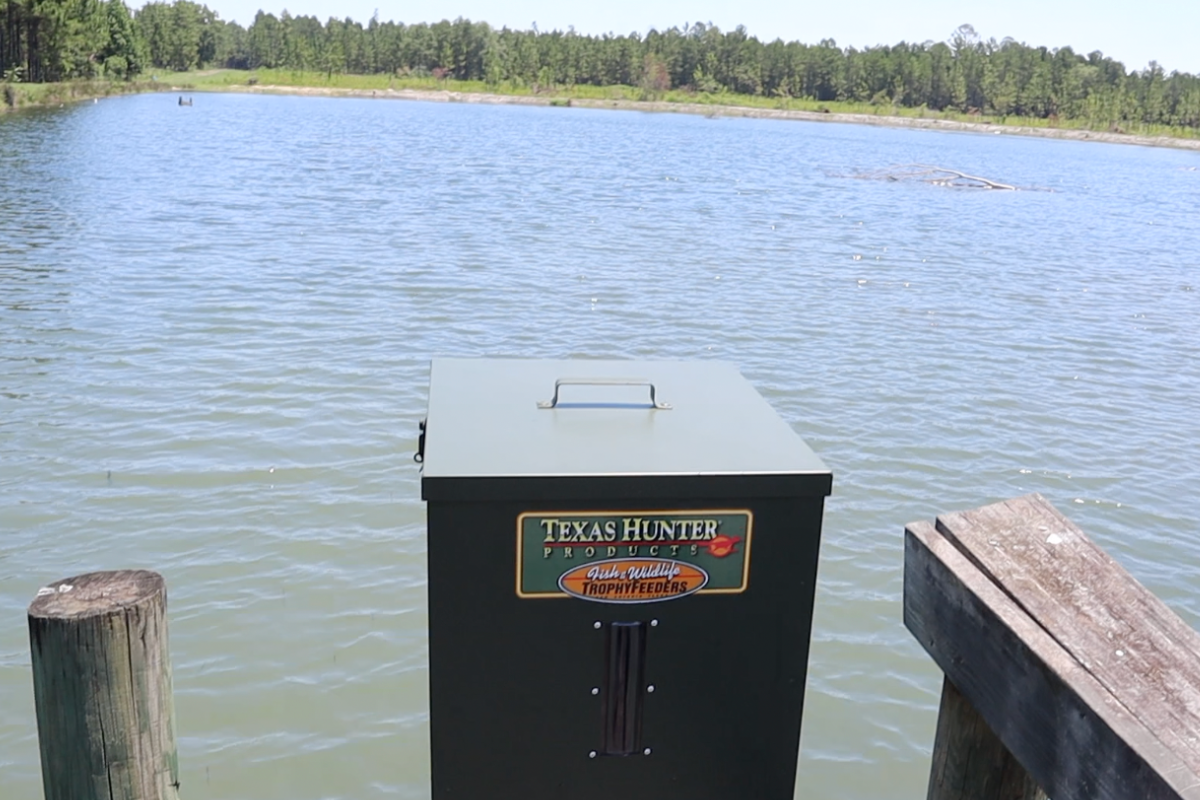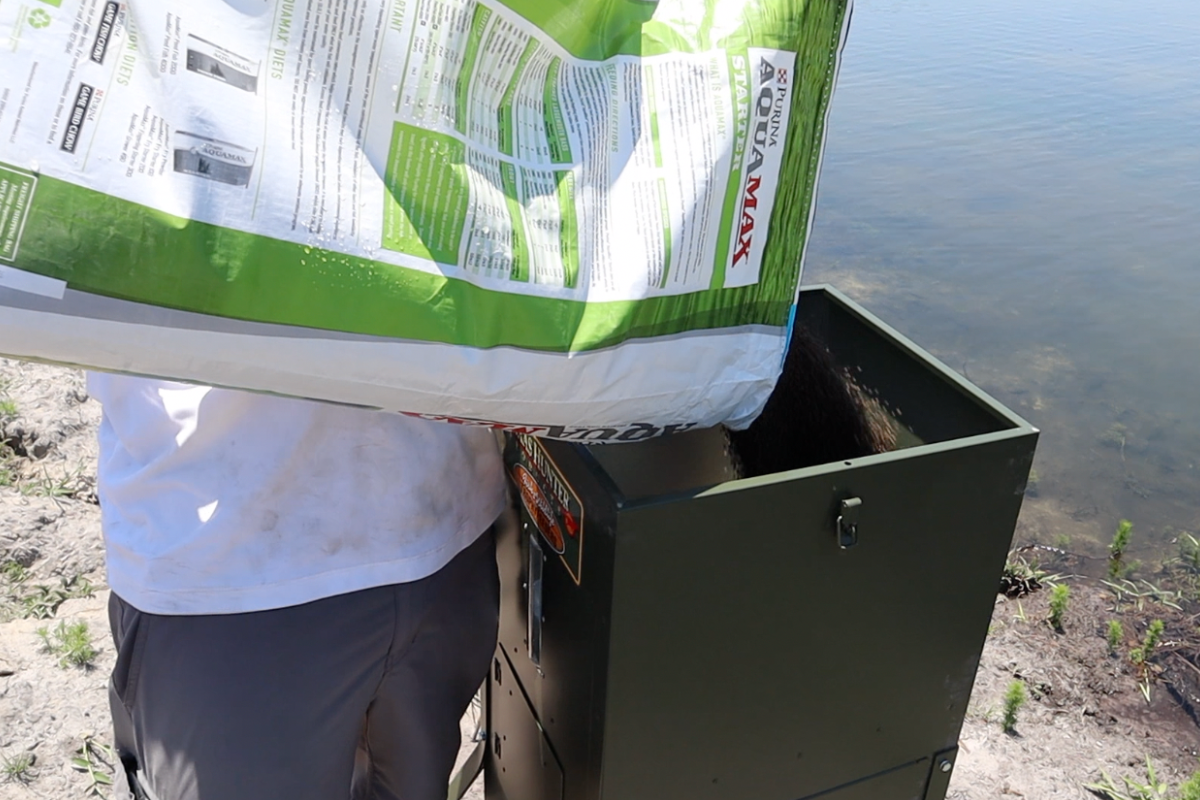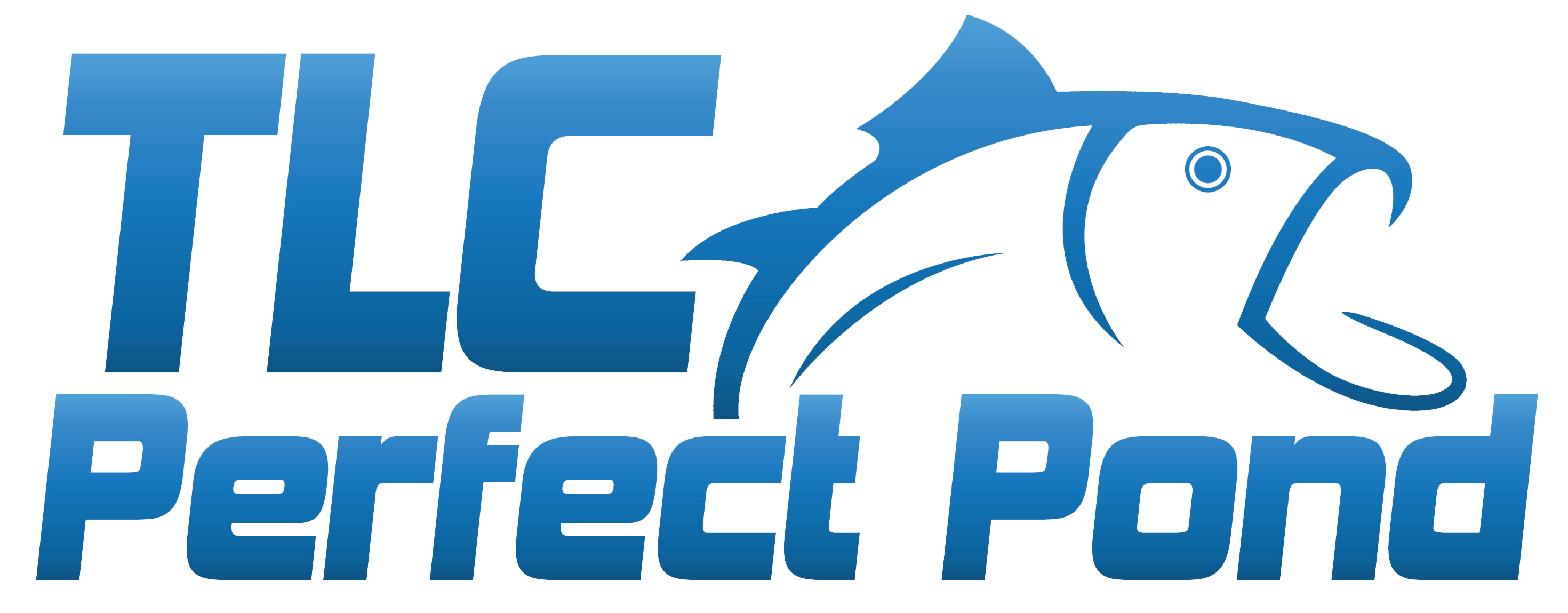One of the biggest issues we see with customers stocking new ponds is that they ‘re not using the right kind of fish food and they’re not feeding at the right frequency. So we wanted to use this blog as an opportunity to discuss our fish feeding strategy and the types of food we prefer to use in newly-stocked and established ponds.
We recommend fish feeders for all of our clients. We prefer the Texas Hunter brand feeders because they’re the most durable and reliable that we’ve found. We recommend purchasing the additional solar charging unit so that these feeders always have constant power and never stop feeding as long as feed is in the feeder.
Using a fish feeder in a small or large pond is a great way to fatten bluegill and have a healthy, robust bluegill population. As we’ve mentioned in previous blogs, the simplified pond food chain starts with plankton that are eaten by sunfish, which are then consumed by bass. If you want to grow big bass, you need a healthy bluegill population.
The number of fish feeders you’ll need depends on the size of the pond. Some experts will recommend 1 fish feeder per 5 acres of water while others will recommend 1 fish feeder per 10 acres of water. We tend to lean towards the 1 fish feeder per 5 acre recommendation. For a recent pond renovation project, we installed two feeders on a 7 acre pond that was completely drained, refilled, and newly stocked with 2-3″ bluegill.

Using Quality Food in Your Fish Feeder
If you’re going to invest in a quality fish feeder, you need to be using quality fish food as well. We frequently see issues with customers using cheap fish food in their feeders and they’re not getting the results they want. Yes, you can go to a local farm supply store and buy a bag of cheap catfish food. But we’re typically not feeding catfish. Our customers are wanting to grow large bluegill and big largemouth bass.
Bluegill and largemouth bass have different nutritional requirements than catfish, and thus will need a different kind of food. We also see quite a few issues with the cheap food clumping in feeders. If you go through a bag of catfish food, you’ll often find clumps which can easily clog fish feeders. The result is that you have to empty the entire fish feeder, find the clumps, make sure it’s clean, and refill it. That’s a lot of work that can be prevented by using a high-quality fish food.
When feeding small fish in a newly stocked pond, we’ll start with Purina Aquamaxx Starter which has a 400 pellet. This is a smaller pellet that works great for 2-3″ bluegill that can’t yet eat a larger pellet. Once those fish grow to 4-5″, we’ll switch to a larger pellet with the Aquamaxx 500. This is what you’ll want to use in ponds with an established fish population.
The nutrition is slightly different between the smaller 400 pellet and the larger 500 pellet fish food. The 400 pellet has 45% protein and 16% fat while the 500 pellet has 41% protein and 12% fat. This is because the smaller fish will need more protein than the larger fish. We also use a good bit of Cargill Triton fish food to occassionally give the fish something different to eat. Purina Aquamaxx and the Cargill Triton are both high-quality fish foods that won’t clog your feeder and they’ll get your fish to size much faster.
We use these feeds on newly stocked bluegill, established bluegill, and also for newly stocked bass. This helps the small bass put on weight quickly so that they can reach spawning size in a shorter amount of time. They’ll also convert the fish food into weight much better than just eating bluegill. Once the bass reach approximately 1 lb in size, they’ll usually stop eating the fish food and start eating more bluegill. But the feeding program helps them get to that point faster.

Feeding Frequency with Your Fish Feeder
Once you’ve got your fish feeder installed and you have some high-quality fish food to put in it, how do you determine how often and how much you should be feeding your fish? Having a solid feeding program requires some management, but it’s all about watching your fish and how they eat.
Bluegill and smaller bass will start feeding heavily when the pond water starts to warm in March here in south Georgia. Once the weather starts to cool in the fall months, the fish won’t eat as much. You’ll need to adjust your feeding frequency and feeding density based on the season so that you’re not feeding more than is necessary.
We feed our established ponds 3 times a day. We set the feeders to throw feed in the morning, mid-day, and late in the evening. We set the feeders to throw as much food as the fish will eat in 10 minutes. If the fish aren’t eating all the food in 10 minutes, we will dial back the feeders to throw less food. If the fish are consuming all the food in less than 10 minutes, we set the feeders to throw more food. We have some customers who are feeding 4-5 times a day in established ponds, and this works if you really want to push your fish populations and get maximal growth.
In a newly stocked pond with 2-3″ bluegill, we’ll initially set the feeder for 1 second per feeding. This is just to allow the small fish to find the food and get used to the feeding times. Some food will be wasted initially during this acclimation process. But once the fish find the feeders and get used to the feeding times, they’ll start consuming it quickly. After this acclimation period, we’ll slowly start increasing the feeding density to 2 seconds and then 3 seconds. We’ll keep increasing the feeding density until we see that they fish aren’t able to consume all the food in 10 minutes.
Some of the better ponds we manage will go through a 50 lb bag of food in a couple weeks. Other ponds with subpar fish populations won’t use that much. But if big bass and big bluegill are your target, give the fish what they need and it will be money well spent. To get big bass, you need big bluegill. And you do that with a solid feeding program and high-quality feed.
Contact Us for More Information
If you’d like to see a fish feeder installation and lean more about feeding bluegill and largemouth bass, click the link below to see this blog in video format. If you are in the south Georgia or North Florida area and could benefit from our pond management services, COMPLETE THIS FORM and we’ll be glad to help.

